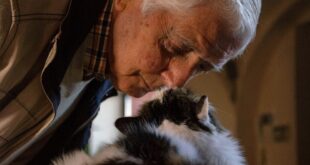As our dogs get older we may notice clouding in their eyes, and a tendency to bump into things. In this article you can discover what cataracts are, and what you can do to help after your vet has made a diagnosis.
Introduction: A cataract develops when the transparent proteins in the lens of the eye become opaque. Cataracts develop gradually over time, and tend to be more common in older dogs. The changes that occur are irreversible, but in humans are treated by simple day-case surgery whereby the lens is removed from the outer capsule and replaced by a clear plastic artificial lens. These operations are increasingly being performed in our companion animals too.
Causes of cataracts: Old age is a definite risk factor. Developmental cataracts can also occur, and diabetes, steroid treatment, infection, and toxicity are also causes. Other causes of cataracts are discussed in more depth on my website.
Why a cataract affects vision: When we see, the rays of light from the object that we are looking at pass through the lens to reach the retina. If the lens is cloudy, the image becomes distorted and cannot focus as well. Initially humans with cataracts see an image as increasingly fuzzy and vague, often with halos of light around objects. This can increase over time to blindness. We can assume that a similar gradual blindness develops in dogs affected by cataracts.
The cloudiness in the lens occurs because the water content in the lens is no longer correct. This leads to increased water content, increased insoluble proteins, and opacity.
Some dogs develop hardening (sclerosis) of the lens as they get older (>10), but this is not a cataract. As it does not affect vision, treatment is not necessary.
Treatments: Treatments include surgery, anti-inflammatory eye drops, antioxidant supplements, and complementary therapies. These treatments are discussed in more detail in the article on my website.
Complementary Therapies: Holistic vets would recommend a review of diet and lifestyle, to ensure that your dog is getting the best nutrients and exercise levels. Natural antioxidants are felt to help sight, and may reduce cataract formation.
Naturopaths believe that free radicals induce the damage that causes cataracts, and may recommend dietary Vitamin E, vitamin C, zinc and selenium to help reduce their progression.
If a dog appears distressed by its loss of vision, then some of the healing therapies such as Reiki and Spiritual healing may help. Massage can comfort the dog, and crystal healing, with blue lace agate and amethyst for example, may help.
Vets advise that the only treatment is surgical. However, there appear to be many eye drops available to help with cataracts.
Summary: In summary, nuclear sclerosis is common in ageing dogs and does not need treatment. Therefore, do not assume that a dog with clouding eyes has cataracts. Get your dog checked by your vet if you are concerned, and this article discusses several additional approaches that may help treat or prevent cataracts.
——
Copyright (c) 2008 TheNaturallyHealthyPet.com
Dr Alison Grimston is a holistic doctor and animal healer. If you are a pet owner or therapist, sign up for her free report on keeping your pet healthy naturally, by logging in at http://www.TheNaturallyHealthyPet.com.








Whitenite - 17 years ago
I found this article extremely interesting